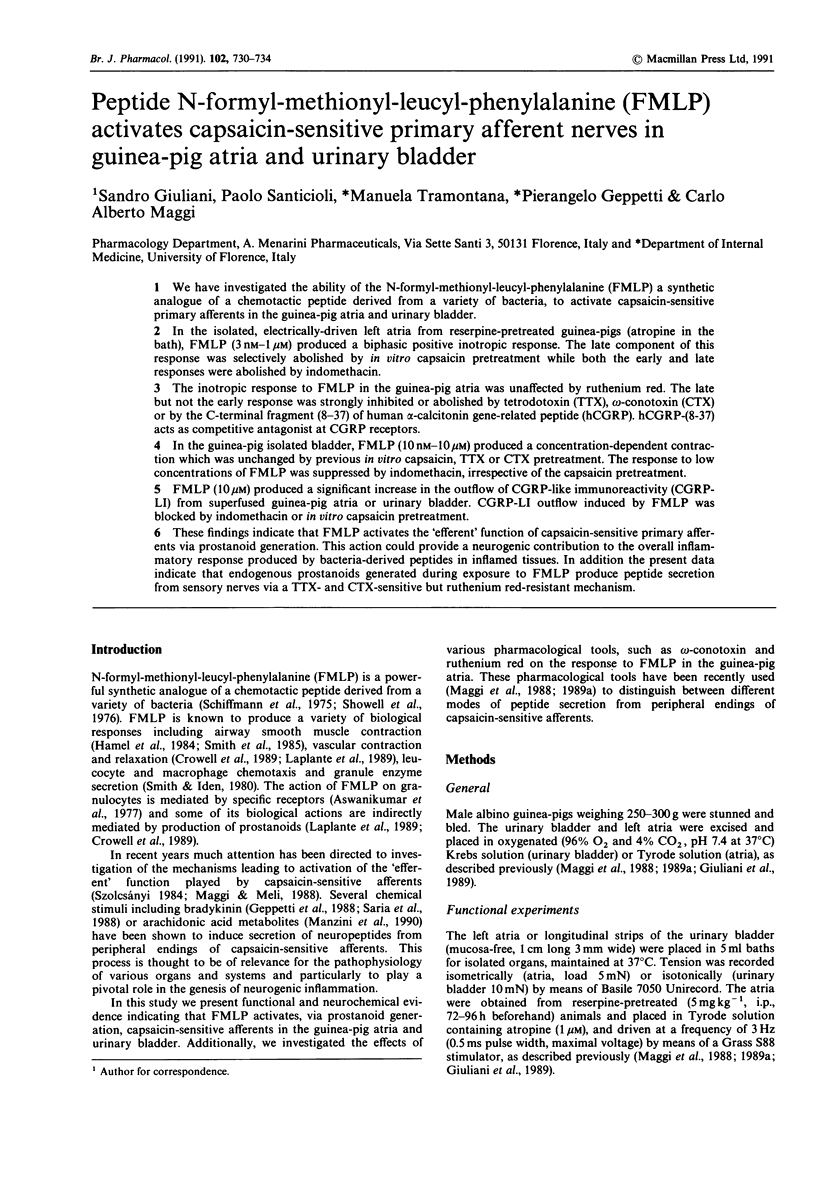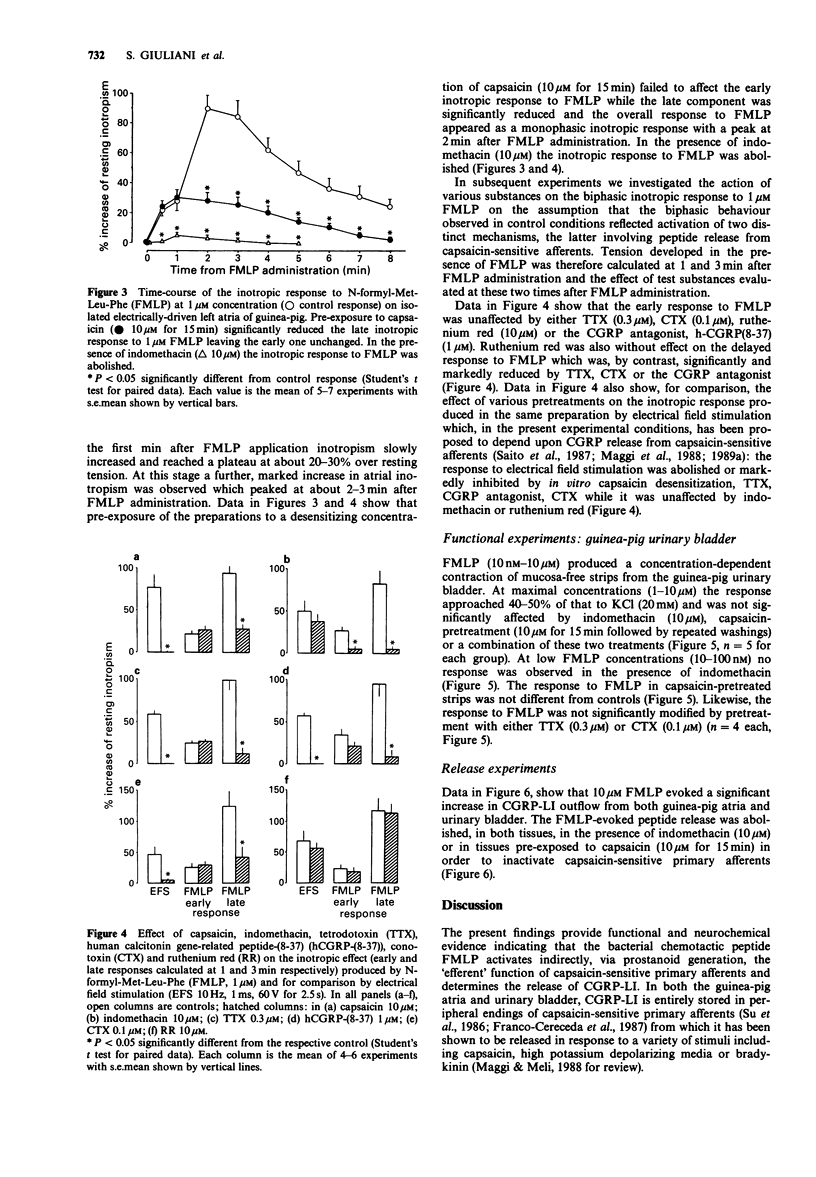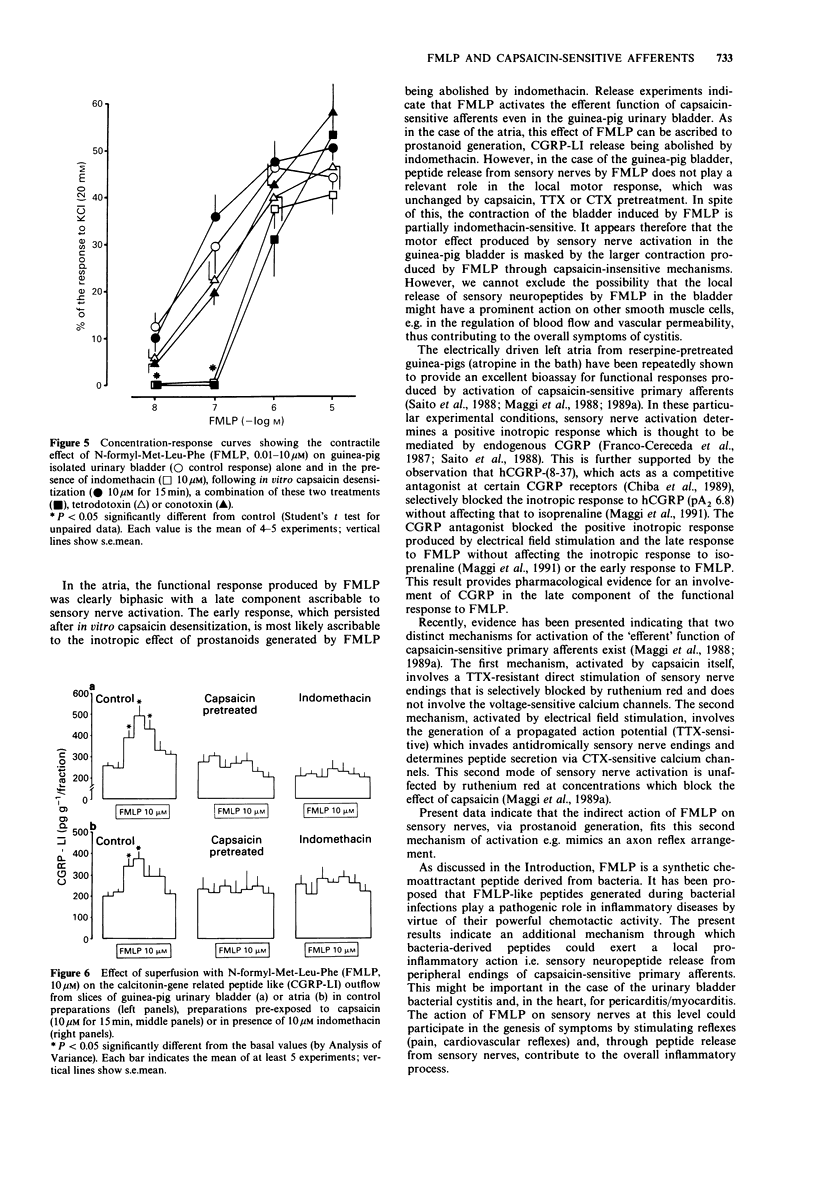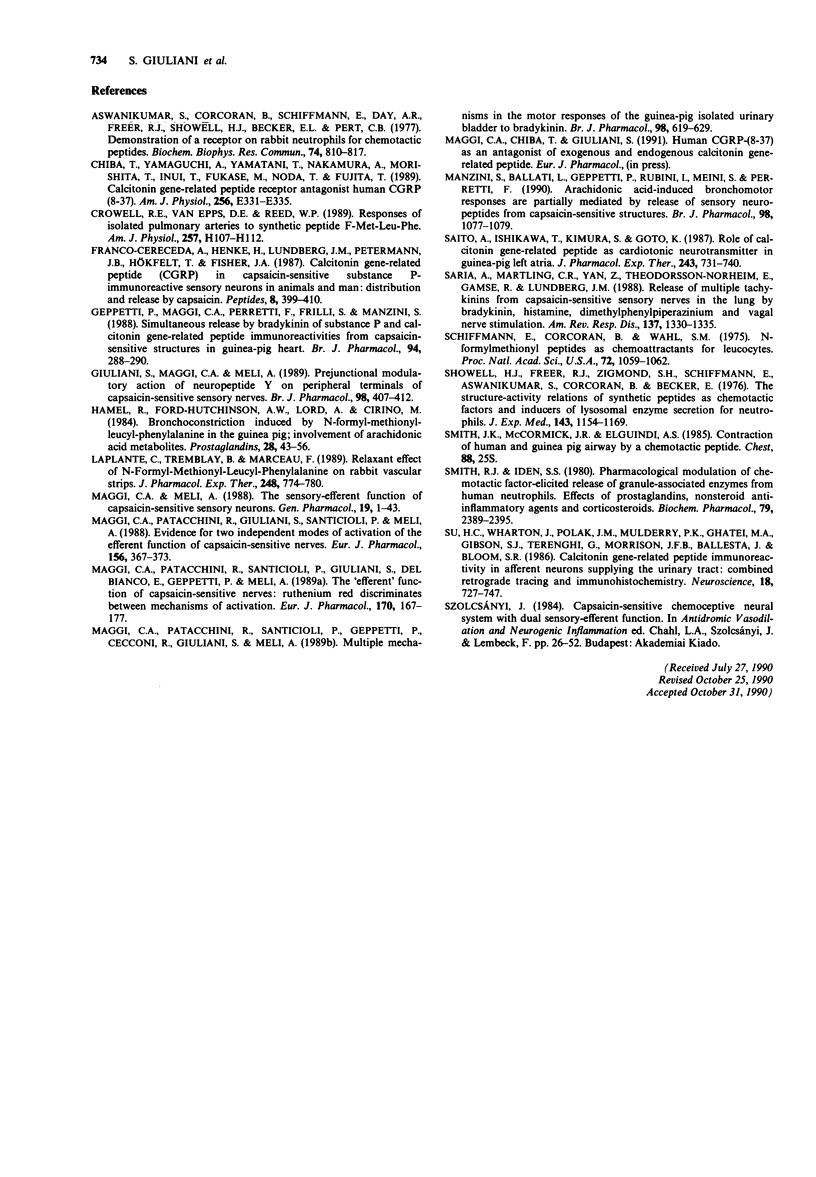Abstract
1. We have investigated the ability of the N-formyl-methionyl-leucyl-phenylalanine (FMLP) a synthetic analogue of a chemotactic peptide derived from a variety of bacteria, to activate capsaicin-sensitive primary afferents in the guinea-pig atria and urinary bladder. 2. In the isolated, electrically-driven left atria from reserpine-pretreated guinea-pigs (atropine in the bath), FMLP (3 nM-1 microM) produced a biphasic positive inotropic response. The late component of this response was selectively abolished by in vitro capsaicin pretreatment while both the early and late responses were abolished by indomethacin. 3. The inotropic response to FMLP in the guinea-pig atria was unaffected by ruthenium red. The late but not the early response was strongly inhibited or abolished by tetrodotoxin (TTX), omega-conotoxin (CTX) or by the C-terminal fragment (8-37) of human alpha-calcitonin gene-related peptide (hCGRP). hCGRP-(8-37) acts as competitive antagonist at CGRP receptors. 4. In the guinea-pig isolated bladder, FMLP (10 nM-10 microM) produced a concentration-dependent contraction which was unchanged by previous in vitro capsaicin, TTX or CTX pretreatment. The response to low concentrations of FMLP was suppressed by indomethacin, irrespective of the capsaicin pretreatment. 5. FMLP (10 microM) produced a significant increase in the outflow of CGRP-like immunoreactivity (CGRP-LI) from superfused guinea-pig atria or urinary bladder. CGRP-LI outflow induced by FMLP was blocked by indomethacin or in vitro capsaicin pretreatment. 6. These findings indicate that FMLP activates the 'efferent' function of capsaicin-sensitive primary afferents via prostanoid generation.(ABSTRACT TRUNCATED AT 250 WORDS)
Full text
PDF




Selected References
These references are in PubMed. This may not be the complete list of references from this article.
- Aswanikumar S., Corcoran B., Schiffmann E., Day A. R., Freer R. J., Showell H. J., Becker E. L. Demonstration of a receptor on rabbit neutrophils for chemotactic peptides. Biochem Biophys Res Commun. 1977 Jan 24;74(2):810–817. doi: 10.1016/0006-291x(77)90375-8. [DOI] [PubMed] [Google Scholar]
- Chiba T., Yamaguchi A., Yamatani T., Nakamura A., Morishita T., Inui T., Fukase M., Noda T., Fujita T. Calcitonin gene-related peptide receptor antagonist human CGRP-(8-37). Am J Physiol. 1989 Feb;256(2 Pt 1):E331–E335. doi: 10.1152/ajpendo.1989.256.2.E331. [DOI] [PubMed] [Google Scholar]
- Crowell R. E., Van Epps D. E., Reed W. P. Responses of isolated pulmonary arteries to synthetic peptide F-Met-Leu-Phe. Am J Physiol. 1989 Jul;257(1 Pt 2):H107–H112. doi: 10.1152/ajpheart.1989.257.1.H107. [DOI] [PubMed] [Google Scholar]
- Franco-Cereceda A., Henke H., Lundberg J. M., Petermann J. B., Hökfelt T., Fischer J. A. Calcitonin gene-related peptide (CGRP) in capsaicin-sensitive substance P-immunoreactive sensory neurons in animals and man: distribution and release by capsaicin. Peptides. 1987 Mar-Apr;8(2):399–410. doi: 10.1016/0196-9781(87)90117-3. [DOI] [PubMed] [Google Scholar]
- Geppetti P., Maggi C. A., Perretti F., Frilli S., Manzini S. Simultaneous release by bradykinin of substance P- and calcitonin gene-related peptide immunoreactivities from capsaicin-sensitive structures in guinea-pig heart. Br J Pharmacol. 1988 Jun;94(2):288–290. doi: 10.1111/j.1476-5381.1988.tb11528.x. [DOI] [PMC free article] [PubMed] [Google Scholar]
- Giuliani S., Maggi C. A., Meli A. Prejunctional modulatory action of neuropeptide Y on peripheral terminals of capsaicin-sensitive sensory nerves. Br J Pharmacol. 1989 Oct;98(2):407–412. doi: 10.1111/j.1476-5381.1989.tb12611.x. [DOI] [PMC free article] [PubMed] [Google Scholar]
- Hamel R., Ford-Hutchinson A. W., Lord A., Cirino M. Bronchoconstriction induced by N-formyl-methionyl-leucyl-phenylalanine in the guinea pig; involvement of arachidonic acid metabolites. Prostaglandins. 1984 Jul;28(1):43–56. doi: 10.1016/0090-6980(84)90112-6. [DOI] [PubMed] [Google Scholar]
- Laplante C., Tremblay B., Marceau F. Relaxant effect of N-formyl-methionyl-leucyl-phenylalanine on rabbit vascular strips. J Pharmacol Exp Ther. 1989 Feb;248(2):774–780. [PubMed] [Google Scholar]
- Maggi C. A., Meli A. The sensory-efferent function of capsaicin-sensitive sensory neurons. Gen Pharmacol. 1988;19(1):1–43. doi: 10.1016/0306-3623(88)90002-x. [DOI] [PubMed] [Google Scholar]
- Maggi C. A., Patacchini R., Giuliani S., Santicioli P., Meli A. Evidence for two independent modes of activation of the 'efferent' function of capsaicin-sensitive nerves. Eur J Pharmacol. 1988 Nov 8;156(3):367–373. doi: 10.1016/0014-2999(88)90282-8. [DOI] [PubMed] [Google Scholar]
- Maggi C. A., Patacchini R., Santicioli P., Geppetti P., Cecconi R., Giuliani S., Meli A. Multiple mechanisms in the motor responses of the guinea-pig isolated urinary bladder to bradykinin. Br J Pharmacol. 1989 Oct;98(2):619–629. doi: 10.1111/j.1476-5381.1989.tb12636.x. [DOI] [PMC free article] [PubMed] [Google Scholar]
- Maggi C. A., Patacchini R., Santicioli P., Giuliani S., Del Bianco E., Geppetti P., Meli A. The 'efferent' function of capsaicin-sensitive nerves: ruthenium red discriminates between different mechanisms of activation. Eur J Pharmacol. 1989 Nov 7;170(3):167–177. doi: 10.1016/0014-2999(89)90537-2. [DOI] [PubMed] [Google Scholar]
- Saito A., Ishikawa T., Kimura S., Goto K. Role of calcitonin gene-related peptide as cardiotonic neurotransmitter in guinea pig left atria. J Pharmacol Exp Ther. 1987 Nov;243(2):731–736. [PubMed] [Google Scholar]
- Saria A., Martling C. R., Yan Z., Theodorsson-Norheim E., Gamse R., Lundberg J. M. Release of multiple tachykinins from capsaicin-sensitive sensory nerves in the lung by bradykinin, histamine, dimethylphenyl piperazinium, and vagal nerve stimulation. Am Rev Respir Dis. 1988 Jun;137(6):1330–1335. doi: 10.1164/ajrccm/137.6.1330. [DOI] [PubMed] [Google Scholar]
- Schiffmann E., Corcoran B. A., Wahl S. M. N-formylmethionyl peptides as chemoattractants for leucocytes. Proc Natl Acad Sci U S A. 1975 Mar;72(3):1059–1062. doi: 10.1073/pnas.72.3.1059. [DOI] [PMC free article] [PubMed] [Google Scholar]
- Showell H. J., Freer R. J., Zigmond S. H., Schiffmann E., Aswanikumar S., Corcoran B., Becker E. L. The structure-activity relations of synthetic peptides as chemotactic factors and inducers of lysosomal secretion for neutrophils. J Exp Med. 1976 May 1;143(5):1154–1169. doi: 10.1084/jem.143.5.1154. [DOI] [PMC free article] [PubMed] [Google Scholar]
- Smith R. J., Iden S. S. Pharmacological modulation of chemotactic factor-elicited release of granule-associated enzymes from human neutrophils. Effects of prostaglandins, nonsteroid anti-inflammatory agents and corticosteroids. Biochem Pharmacol. 1980 Sep 1;29(17):2389–2395. doi: 10.1016/0006-2952(80)90274-9. [DOI] [PubMed] [Google Scholar]
- Su H. C., Wharton J., Polak J. M., Mulderry P. K., Ghatei M. A., Gibson S. J., Terenghi G., Morrison J. F., Ballesta J., Bloom S. R. Calcitonin gene-related peptide immunoreactivity in afferent neurons supplying the urinary tract: combined retrograde tracing and immunohistochemistry. Neuroscience. 1986 Jul;18(3):727–747. doi: 10.1016/0306-4522(86)90066-7. [DOI] [PubMed] [Google Scholar]


